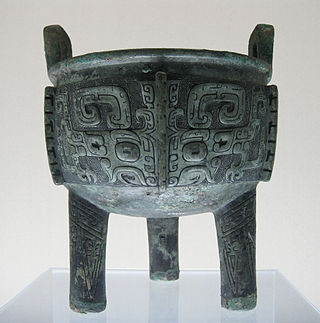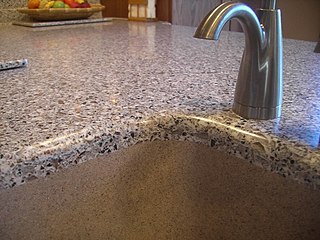
A composite material is a material which is produced from two or more constituent materials. These constituent materials have notably dissimilar chemical or physical properties and are merged to create a material with properties unlike the individual elements. Within the finished structure, the individual elements remain separate and distinct, distinguishing composites from mixtures and solid solutions.

A workbench is a sturdy table at which manual work is done. They range from simple flat surfaces to very complex designs that may be considered tools in themselves. Workbenches vary in size from tiny jewellers benches to the huge benches used by staircase makers. Almost all workbenches are rectangular in shape, often using the surface, corners and edges as flat/square and dimension standards. Design is as varied as the type of work for which the benches are used but most share these attributes:

In materials science, a thermosetting polymer, often called a thermoset, is a polymer that is obtained by irreversibly hardening ("curing") a soft solid or viscous liquid prepolymer (resin). Curing is induced by heat or suitable radiation and may be promoted by high pressure, or mixing with a catalyst. Heat is not necessarily applied externally, but is often generated by the reaction of the resin with a curing agent. Curing results in chemical reactions that create extensive cross-linking between polymer chains to produce an infusible and insoluble polymer network.

Injection moulding is a manufacturing process for producing parts by injecting molten material into a mould, or mold. Injection moulding can be performed with a host of materials mainly including metals, glasses, elastomers, confections, and most commonly thermoplastic and thermosetting polymers. Material for the part is fed into a heated barrel, mixed, and injected into a mould cavity, where it cools and hardens to the configuration of the cavity. After a product is designed, usually by an industrial designer or an engineer, moulds are made by a mould-maker from metal, usually either steel or aluminium, and precision-machined to form the features of the desired part. Injection moulding is widely used for manufacturing a variety of parts, from the smallest components to entire body panels of cars. Advances in 3D printing technology, using photopolymers that do not melt during the injection moulding of some lower-temperature thermoplastics, can be used for some simple injection moulds.

Bronze is the most popular metal for cast metal sculptures; a cast bronze sculpture is often called simply "a bronze". It can be used for statues, singly or in groups, reliefs, and small statuettes and figurines, as well as bronze elements to be fitted to other objects such as furniture. It is often gilded to give gilt-bronze or ormolu.

Boat building is the design and construction of boats and their systems. This includes at a minimum a hull, with propulsion, mechanical, navigation, safety and other systems as a craft requires.

Lost-wax casting is the process by which a duplicate metal sculpture is cast from an original sculpture. Intricate works can be achieved by this method.
Fibre-reinforced plastic is a composite material made of a polymer matrix reinforced with fibres. The fibres are usually glass, carbon, aramid, or basalt. Rarely, other fibres such as paper, wood, or asbestos have been used. The polymer is usually an epoxy, vinyl ester, or polyester thermosetting plastic, though phenol formaldehyde resins are still in use.
This page describe terms and jargon related to sculpture and sculpting.
Gelcoat, also called Gel Coat, is a material used to provide a high-quality finish on the visible surface of a fibre-reinforced composite. The most common gelcoats are thermosetting polymers based on epoxy or unsaturated polyester resin chemistry. Gelcoats are modified resins which are applied to moulds in the liquid state. They are cured to form crosslinked polymers and are subsequently backed with thermoset polymer matrix composites which are often mixtures of polyester resin and fiberglass, or epoxy resin which is most commonly used with carbon fibre for higher specific strength.

Investment casting is an industrial process based on lost-wax casting, one of the oldest known metal-forming techniques. The term "lost-wax casting" can also refer to modern investment casting processes.
Bulk moulding compound (BMC), bulk moulding composite, or dough moulding compound (DMC), is a ready-to-mold, glass-fiber reinforced thermoset polymer material primarily used in compression moulding, as well as in injection moulding and transfer moulding. Typical applications include demanding electrical applications, corrosion resistant needs, appliance, automotive, and transit.

Glass casting is the process in which glass objects are cast by directing molten glass into a mould where it solidifies. The technique has been used since the 15th century BCE in both Ancient Egypt and Mesopotamia. Modern cast glass is formed by a variety of processes such as kiln casting or casting into sand, graphite or metal moulds.

Epoxy granite, also known as synthetic granite, is a polymer matrix composite and is a mixture of epoxy and granite commonly used as an alternative material for machine tool bases. Epoxy granite is used instead of cast iron and steel for improved vibration damping, longer tool life, and lower assembly cost, and thus better properties for stabilizing and housing machines.
Spray-Up also known as chop method of creating fiberglass objects by spraying short strands of glass out of a pneumatic gun. This method is used often when one side of the finished product is not seen, or when large quantities of a product must be made cheaply and quickly without regards to strength. Corvette fenders and boat dinghies are commonly manufactured this way.
The Plastic automotive engine has its origins in the late 1970s with research and work done by Matthew (Matti) Holtzberg of Polimotor Research and his associates. Since then Holtzberg and others have done steady work in the field.

Solid surface is a man-made material usually composed of a combination of alumina trihydrate (ATH), acrylic, epoxy or polyester resins and pigments. It is most frequently used for seamless countertop installations.

Casting is a manufacturing process in which a liquid material is usually poured into a mold, which contains a hollow cavity of the desired shape, and then allowed to solidify. The solidified part is also known as a casting, which is ejected or broken out of the mold to complete the process. Casting materials are usually metals or various time setting materials that cure after mixing two or more components together; examples are epoxy, concrete, plaster and clay. Casting is most often used for making complex shapes that would be otherwise difficult or uneconomical to make by other methods. Heavy equipment like machine tool beds, ships' propellers, etc. can be cast easily in the required size, rather than fabricating by joining several small pieces.
A casting defect is an undesired irregularity in a metal casting process. Some defects can be tolerated while others can be repaired, otherwise they must be eliminated. They are broken down into five main categories: gas porosity, shrinkage defects, mould material defects, pouring metal defects, and metallurgical defects.
A Lay-Up process is a moulding process for composite materials, in which the final product is obtained by overlapping a specific number of different layers, usually made of continuous polymeric or ceramic fibres and a thermoset polymeric liquid matrix. It can be divided into Dry Lay-up and Wet Lay-Up, depending on whether the layers are pre-impregnated or not. Dry Lay-up is a common process in the aerospace industry, due to the possibility of obtaining complex shapes with good mechanical properties, characteristics required in this field. On the contrary, as Wet Lay-Up does not allow uni-directional fabrics, which have better mechanical properties, it is mainly adopted for all other areas, which in general have lower requirements in terms of performance.
The main stages of the Lay-Up process are cutting, lamination and polymerization. Even though some of the production steps can be automated, this process is mainly manual, leading to laminates with high production costs and low production rates with respect to other techniques. Hence, nowadays, it is mainly suitable for small series production runs of 10 to 1000 parts.












